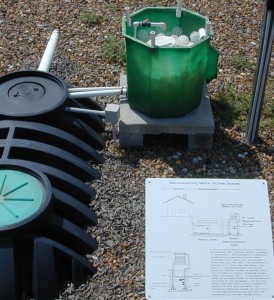 Trickling filters provide aerobic treatment of wastewater. Wastewater is generally pumped from a recirculation tank or compartment, dispersed over a media bed, and allowed to drain back into the recirculation tank. The wastewater is aerated as it flows through the media bed, which may consist of a variety of media such as tire chips, stone, and rigid plastics configured into a number of shapes (i.e., honeycomb blocks, rings, or cylinders). A trickling filter uses filtration, adsorption, and assimilation for removal of contaminants from wastewater. Wastewater should flow in a thin film over the media to allow time for treatment.
Trickling filters provide aerobic treatment of wastewater. Wastewater is generally pumped from a recirculation tank or compartment, dispersed over a media bed, and allowed to drain back into the recirculation tank. The wastewater is aerated as it flows through the media bed, which may consist of a variety of media such as tire chips, stone, and rigid plastics configured into a number of shapes (i.e., honeycomb blocks, rings, or cylinders). A trickling filter uses filtration, adsorption, and assimilation for removal of contaminants from wastewater. Wastewater should flow in a thin film over the media to allow time for treatment.
The media serves as a substrate where a biological film grows and is fed by the nutrients contained in the wastewater. As the biological film establishes and continues to grow, it will eventually exceed its own ability to cling to the media surface. The biological film material breaks off and washes down through the media bed, and either returns to the recirculation tank or settles out in a clarifier compartment. The clarifier typically contains a solids return pump dedicated to moving accumulated biological materials back to the head works of the septic tank for decomposition.
Effluent passing through the trickling filter can return to the recirculation tank or a portion of the flow can be directed to the final treatment and dispersal component.
Related Resources:
 Trickling Filter (and in Spanish)
Trickling Filter (and in Spanish)
